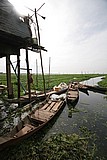Home |
Restaurants by City
|
Food Photography |
Archive | Philosophy |
![]()
Right now we are eating in Seattle, Washington.
|
Monday
2006
Permalink
|
Being in Cambodia, December 6-10, 2005 ó (Note: I know this is a food blog, but I was really touched by my trip to Cambodia so today in the first of two posts on the country I want to give some background on my experience there.) I am guilty of romanticizing southeast Asia. Itís dangerous to do it as at best youíll end up disappointed and at worst it can be condescending. That said, thereís no denying the romance and beauty of the region. Iíve wanted to travel here for much of my life and have finally gotten to make the trip. And in many ways, in my mind, Bangkok was always the iconic representation of what I hoped to see. Iím not sure how to express what I was hoping for. I think the fact that I love Asian food and Asian aesthetics combined with the prospect of encountering a really different society and culture where those came from was attractive. And I fully expected Bangkok to be the highlight of my trip. In fact, (and this is probably my fault for not getting far enough off the beaten path,) Bangkok seemed to me two dimensional. I admit this is because I only had a few days and I wasnít able to break out of the tourist routes. But thatís part of the problem, breaking out of the well worn tracks that zillions of tourists have beaten down before you. And in many ways, everywhere I went in Bangkok was optimized for tourists. I almost went down the same path in Phnom Penh. Almost. Phnom Penh was immediately different than Bangkok. Bangkok is clearly on its way to becoming a world class city. It's decades (or longer) from having the polish of London or Tokyo, but all the basic elements are in place Ė the excitement, the breadth, the depth, the special qualities. Phnom Penh is dusty, itís small (relatively), its dilapidated, its broken. The National museum houses a tiny fraction of the treasures this country once had, but looting, the Kmher Rouge, and civil war have seen most of it leave the country. The museum itself is beautiful and sad. He objects are nice, but the building is gorgeous. Itís also worn and frayed. But itís worn and frayed from use as well as abuse. And ultimately itís sad and endearing. I know that Bangkok is dusty and dilapidated as well, and I donít mean to condescend, but really, Phnom Penh may be leaps and bounds ahead of where it was during the Cambodia civil war, but it feels (to me) like a I would imagine Bangkok felt 20-30 years ago. And yet, Phnom Penh is clearly alive. The people are going about their day, every day, and there are tons of them. The streets are teeming with Cambodian faces. And just about all of them are quick to offer a genuine smile. Commerce is everywhere. I mean everywhere Ė stuffed into every nook and cranny that can handle someone selling something. People arenít just selling (and buying Ė though it appears thereís 10 vendors for every customer), but they are living their lives. One of my favorite moments so far was riding past a local school at 5pm just as streams of kids were pouring out of the gates of the school all in their blue and white uniforms. Tons of parents on motorbikes were picking up their kids and taking them home. It was just another day. And there it was, I found the Bangkok I was looking for, it is Phnom Penh. It's important to remember a few things though:
In other words. This is a fucked up place. Beautiful. Lovely friendly people. But a fucked up place nonetheless. Tomorrow, in part 2, we talk about eating in Cambodia.
|
|||
Our Sponsors
Free Car Listings Ė Hot Tubs Ė Stools Ė Saunas Ė Bar Stools - Calendar and Event Schedules - Food Events and Calendars - Wine Events and Calendars - Digital Photography Resources - Software for Advertisers - Jewish Gifts and Judaica - Howard Stern Podcast - ponytailed blogger Jonathan Schwartz

Browse tastingmenu
Home |
Restaurants by City X |
Food Photography |
Archive | Philosophy |
![]()
Free eBooks: All About Apples
| Autumn Omakase
More:
Discussion |
Cool Food T-Shirts |
Ingredients
| Markets |
Recipes
Search |
Blog FAQ |
Other
Blogs
Best of tastingmenu
|
City View
Entry: July 6, 2006 |
Blue Plate
Entry: June 19, 2006 |
L'Atelier de JoŽl Robuchon
Entry: July 18, 2006 |
Browse by City
Boston | Chicago | Houston | Las Vegas | Los Angeles | Maui | New York | Philadelphia | Portland | San Francisco | Seattle | Toronto | Utah | Vancouver | Washington D.C.
Bangkok | Beijing | Hong Kong | Seoul | Tokyo
Amsterdam | Berlin | Italy | London | Madrid | Paris | Vienna
Browse by Month
2006
2005
2004
2003
2002
2001
Comments, questions, or feedback:
info / at / tastingmenu / dot / com
All pages Copyright (c) 2001-2006 tastingmenu.com
Last modified 01/30/07.





